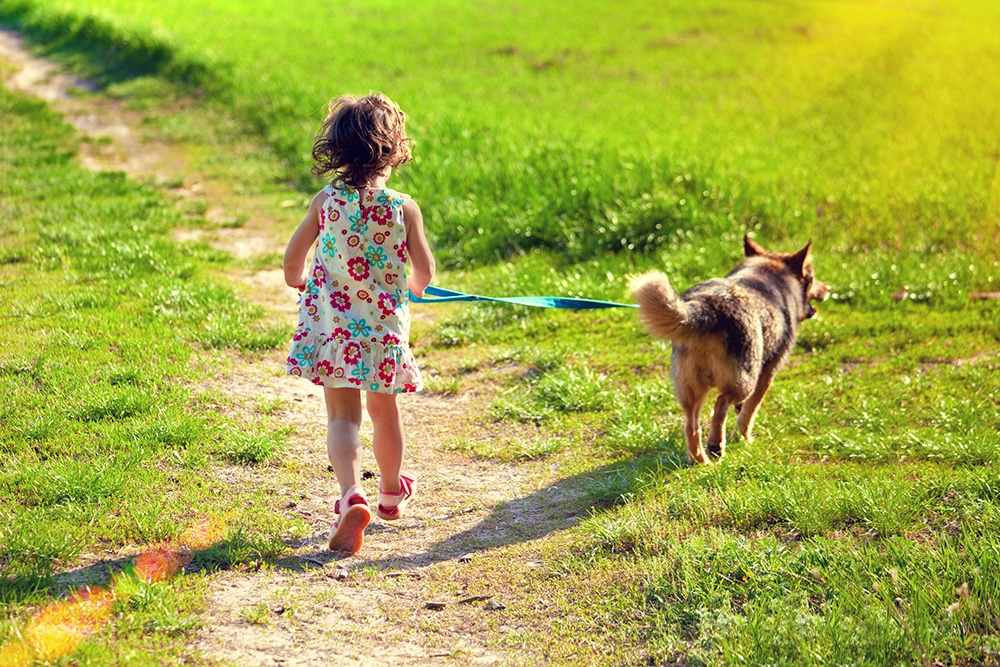MED-EL
Published Apr 29, 2016
Build Language Skills: Take the Dog for a Walk

If you’ve got a dog, odds are that you’ll take it out for a walk quite a bit. Here are some ways that you can turn a simple walk into exciting activities to help your child develop listening and language skills.
Talk about Everything
As you’re walking around, talk about everything that you see or smell or do. The goal here is to expose your child to as many different words as possible, in a meaningful way. The more they hear you speak, the more chances they’ll have to develop their listening and language skills.
- Have your child help you prepare, by gathering up everything you need. When doing this, get your child to listen to the items you need before you get them.
- Tell your child all the different things you’ll use on the walk, like a leash, a doggie bag, or maybe a jacket.
- Ask your child to gather up some of these things without pointing to them, or using other visual clues: “Can you get the leash from the closet?”
- Talk about the weather to help develop your child’s vocabulary around this topic:
- “Look how the sun is bright! It’s certainly making the weather warm.”
- “The clouds are big and white today!”
- “Can you smell the flowers?”
- Compare your dog to other dogs or animals:
- “That dog is bigger than our dog!”
- “Our dog has brown fur, and that dog has white fur!”
- Encourage your child to talk with the dog, and give commands:
- Say something to the dog, like “Sit, dog, sit!”
- Then, tell your child to say something similar: “If we want the dog to sit, we tell it to sit: ‘Sit, dog, sit.’ Now you tell it to sit!”
Engage Your Child’s Imagination
You, your child, and even your dog will all have different thoughts—and you can use a walk to show your child how everyone has these different thoughts.
Ask your child what they are thinking, or what they think the dog thinks:
- As you’re walking around, include your child in decision making:
- Where do you think the dog wants to go?
- Where would you want to go, if you were a dog?
- If you’re in town, ask your child about the surroundings:
- I can smell popcorn! Do you think the dog likes popcorn?
- What sorts of treats do you think the dog likes?
This idea, that we all have our own thoughts—and our thoughts can be different from other people’s—is called “Theory of Mind.” You can read more about ToM with these blog posts:
- What Theory of Mind has to do with listening skills
- Reading books to build Theory of Mind skills
- 5 ways to develop Theory of Mind skills
Create an Experience Book
You can keep practicing these words and ideas at home, by making an experience book. An experience book is like a diary, except you and your child make it together.
- Collect memories as you’re on the walk:
- Take pictures of you, your dog, your child, and where you’ve gone.
- Pick up some mementos, like leaves or grass from a park you played in.
- When you’re back at home, grab some construction paper and fold it into a book shape with lots of pages. Fill those pages with your memories while building your child’s listening and language skills by revisiting them together. Experience books are a great way to use natural repetition of language and concepts that your child has been learning in their day to day experiences:
- Print out the pictures you’ve taken. Glue them into the book in a chronological order. You can help your child build their sequencing skills by asking them to help: “First we walked down the sidewalk. Then what did we do?” and have them answer what happened next.
- On each page, write down what happened when the picture was taken: what the dog did, and what some of the consequences were. For example, the dog may have chased the ball and did not bring it back. As your child what happened because the dog did not bring the ball back, and how this made your child feel.
- Add in some of the leaves or grass to make the book look creative and more beautiful. You can help your child build their memory by asking them to talk about where the leaves or grass came from: “This is a big, red leaf! Do you remember where we found it?”
- When you’ve made the book, don’t let it gather dust! Come back to it over and over, repetition and re-reading the same story is a great way to build your child’s language skills.
For more information on making an experience book, check out this blog post: Help your child develop listening skills with an experience book.
Subscribe to the MED-EL blog for more hands-on activities and exercises that you can use to build your child’s language skills—we publish one each Friday!
This post was written with help from Joanna Brachmair, a rehabilitation specialist at MED-EL.
MED-EL
Was this article helpful?
Thanks for your feedback.
Sign up for newsletter below for more.
Thanks for your feedback.
Please leave your message below.
Thanks for your message. We will reply as soon as possible.
Send us a message
Field is required
John Doe
Field is required
name@mail.com
Field is required
What do you think?
MED-EL


